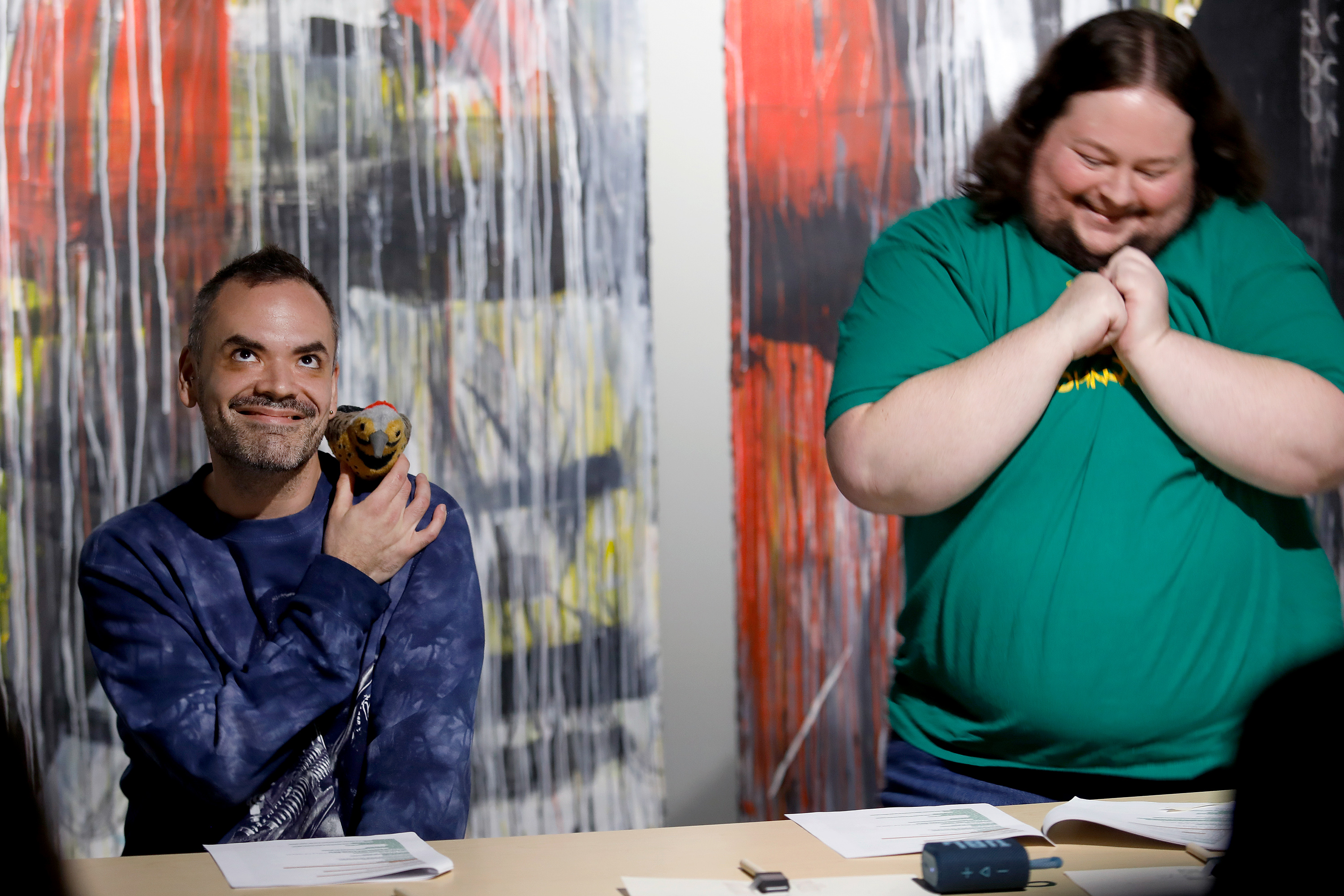Culture
Chachalu ‘Ikanum’ exhibit opens next to ‘Stik’

By Sherron Lumley
Smoke Signals staff writer
“Ikanum: Stories from the Pacific Northwest,” the annual multi-artist exhibit of Chachalu Museum & Cultural Center, opened Thursday, Nov. 30, and will continue through March 30.
“This is our fifth year of an annual winter installation that predates Chachalu,” Chachalu Curator Travis Stewart said. “The premise of ikanum is traditional storytelling.”
The show features artwork from several Grand Ronde Tribal members and others. It includes a range of materials and styles, from photography to painting, drawing, traditional crafts and contemporary abstract.
“Some are deeply personal and others are whimsical and fun,” Exhibits Coordinator Lyle Cairdeas said. “Depending on the piece, it may be about learning lessons, loss, heartache, new beginnings or healing. What I love about the exhibit is that it runs the gamut of emotions.”
On opening night, artist and Tribal member Leland Butler spoke about his untitled triptych: Three large photographs taken at approximately 5 p.m. on July 16 at a North Dakota powwow. In the first and third photos, a woman is dancing alone against a gray sky.
“The jingle dress is a healing dance, a woman’s dance,” Butler, who also sings at powwows, said. “Sometimes, families are mourning and it is a memorial special. They come to honor older relatives who are alive, too. It is also a contest (dance).”
On the day the photos were taken, Canadian wildfires caused smoky skies, diffusing the light of the sun and creating a subtle glowing orb behind the dancers.
As part of the show, visitors to the museum are encouraged to explore how the artwork and the story make it a complete experience.
Tribal member Joseph Ham’s entry is a hand-colored drawing of a warrior. The drawing itself was done in 2004 by his cousin Timothy Leonard Ham, son of Alan and Sharon (Quickbear) Ham. The story behind it is a deeply personal one and a picture of the cousins as children is tucked into the corner.
Joseph Ham described coloring the drawing on the day of Timothy’s funeral as a form of catharsis. As children, they enjoyed drawing together. Ham submitted the work with permission from his uncle, who also came to the opening.
“I found it a couple of years ago,” Ham said. “He was only 17 when he passed away in 2004, five years older than me. We miss him a lot. It’s hard, but it feels good to talk about him.”
Artists in the current exhibit include Lofanitani Aisea, Maret Banks, Leland Butler, Lyle Cairdeas, Kitana Connelly, David Franklin, Jon A. George, Joseph and Timothy Ham, Raven Harmon, Reahena LaBonte, Flicka LaBonte Lucero, Bobby Mercier, Jordan Mercier, Sara Siestreem, Crystal Starr, Travis Stewart, Terresa White, Matthew Earl Williams and Shirod Younker.
Later in the evening, Tribal members Felix Furby and Anthony Hudson presented the ikanum “Hazel Drumstick Gambler,” a traditional tale translated from Clackamas Chinook to modern English. They welcomed audience interpretation and discussion.
“Listening to ikanum, it will speak to you a little differently each time,” Furby said.
He began working with the “Drumstick” story in 2020. The tale includes a bit of magic and ambiguity. “We see the gay and you may not. Queer people see it as a queer story, straight people see straight.”
The audience gathered around to listen to the ikanum, which combined multiple voices, visual elements and a 1929 recording of Clackamas Chinook storyteller Victoria Howard singing to bring the tale to life.
The work that went into presenting the ikanum is a glimpse into Furby and Hudson’s research and cultural revitalization efforts that includes a recent two-spirit/Indigiqueer installation at Chachalu called “Shimkhin.” They will return to Chachalu in 2024 with an expanded installation through grant funding from the Oregon Community Foundation and the Native American Cultural Foundation.
“We see in Grand Ronde enough safety to pursue this,” Furby said. “I see this as working on our intergenerational trauma. You need some semblance of safety first. There is a degree of vulnerability.”
“We are seeing mass hysteria legislating against queer people and trans people,” Hudson said. “One way to combat that is to go back to our cultural traditions. We have always been here, queerness is a cultural identity.”
“Even the original language does not hold all of the cultural context,” Furby said. “There is a lot of care that goes into storytelling. We went back to the original Clackamas to improve the 1929 translation by Melville Jacobs.”
Running parallel to “Ikanum,” Chachalu’s “Stik” exhibit continues through February and is a four-part installation featuring stories from the forest. It follows Tribal interaction with the forest from time immemorial to pre-Termination, pre-Restoration and modern times, coming back around to time immemorial and the revitalization of cultural practices.
